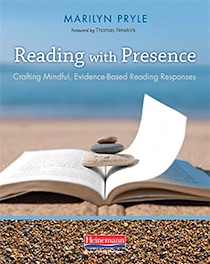This is Marilyn’s second in a series of articles about the 5 Questions teachers can use to help students become more critical readers with any text in any format. For more background about this, please see her previous articles 5 Questions to Help Kids Become Critical Readers and Question #1 – What Am I Reading?
By Marilyn Pryle
 In my last article I examined the question “What Am I Reading?” and discussed the importance of noticing not only genre but an author or creator’s background, cultural values, actual intended audience, and possible backers.
In my last article I examined the question “What Am I Reading?” and discussed the importance of noticing not only genre but an author or creator’s background, cultural values, actual intended audience, and possible backers.
Once the idea of “What actually is this?” is addressed in the reader’s mind, they can also think about what the text (or video, audio, meme, and so on) is saying. However, I purposefully don’t use the word “saying,” because I want to go even deeper than that. Instead, I use showing.
Question #2: What Is the Text Showing?
This question addresses the basic function of any text in any form: communicating information. As I mentioned above, this question is usually phrased as What is the text saying? Teachers often lead with this “saying” question; students learn from an early age to figure this out. Indeed, it is the purpose of all reading instruction and the basis for most subjects in school. Extracting semantic meaning from texts is the traditional priority of education.
The problem with that approach, however – besides that fact that it skips the first question (What am I reading?) – is that it assumes an author is giving the reader a “right” answer, something to be learned and internalized, something to be unquestionably consumed, and our job as readers is to figure out, unpack, or puzzle through what that right answer is.
It assumes the author-centric stance that the text contains information that we need and that we must work to crack open in order to benefit from it.
“Showing” vs. “Saying”
We must go beyond a surface-level inquiry of What is the text saying? – an inquiry that assumes the text is a perfect vessel containing a useful truth – and teach students to instead ask What is the text showing? The difference between “saying” and “showing” is an important one, one that differentiates between taking a text at face value and realizing the behind-the-scenes influences that swirl around any created thing.
It is the difference between reading for The Right Answer and reading for a larger meaning. It is the difference between reading passively and reading critically. Even if the goal is to figure what a text is “saying” so that one may disagree, the initial stance of passivity remains intact; what I’m arguing for here is a shift in our mental framework, a repositioning of agency.
A text will always show its true beliefs, influences, culture, and ideology beyond the words on the page or the images on a screen. It is impossible to avoid this fact; the clues always exist. Perhaps these clues are in the minor details, as when certain assumptions reveal a particular worldview.

Perhaps the clues are in the phrasing, as when a certain term reveals a deeper belief about class, race, gender, or the environment. Perhaps the clues are in the structure, as when a narrative format reveals training in the Eurocentric works that have traditionally been taught in American and British Literature classes.
Yes, the information in the words of a text is important. But we must teach students to look more fully and to question more incisively into a text if they are to become more critical readers who approach texts with confidence and agency.
We must stop indoctrinating students to search for right answers and instead teach them how to engage with texts in an informed, inquisitive, and holistic way. From the understanding that all texts are created within the boundaries of time, space, culture, and ideology, students can ask, What is this text showing me?
Using Reading Responses to Implement this Question
If you are new to my method of Reading Responses, please see my previous articles about it, as well as my book Reading with Presence. In short, a Reading Response consists of an original thought, a metacognitive category, a cited quote, and five sentences. In my class we do at least one a day, thus making it a constant, low-stakes writing practice (see my four rules here).
To implement Question #2, I give students Reading Response categories such as:
- Economic Impact
- Eco Criticism
- Feminist Theory
- Investigating Institutions
- Heeding the Herd
- Recognizing Racial Impact
- Seeing Stereotypes
- Beauty Bias
- Gender Roles
- Queer Theory
- Witnessing Whiteness
- Investigating Abilities
- Tell the Central Message
- Cite the Claim
- Tracing Cause and Effect
- Pros and Cons
Each of these categories comes with some prompting questions to help students explore their thinking on the topic, and students can always choose the category they want to respond in. Think about how each of these categories connect to Question #2 – What is it showing?
Some of the categories look for an answer that might be stated outright, such as finding a central message or claim, listing the pros and cons, or naming causes and effects. Others, however, fall into more of the showing category – ideas that might not be stated on the surface, but they are revealed in other ways. These could include attitudes or beliefs about the environment, class, race, gender, beauty, or institutions.
Giving students a space to look more deeply into these issues, and how they surface in a text, will increase their critical capacities. Here’s an example. Look at the prompt and student example below for Investigating Institutions:
►Investigating Institutions
How do larger systems or institutions work in the text? (An “institution” can be a school, government, company, or any larger group that guides or controls individuals in some way.) Do the institutions support some and subvert others? How so?
Investigating Institutions for The Giver, by Samreen
In the book The Giver by Lois Lowry, the government decides almost everything for the community. The only thing the community gets to make a choice about is where they get to spend their volunteer hours. Jonas, the main character, states that he likes the ability to choose how he spends his time because “the freedom to choose where to spend those hours had always seemed a wonderful luxury to Jonas; other hours of the day were so carefully regulated” (Lowry 26).
Though the government has very strict rules, they still allow for flexibility. This is most likely to give the illusion that the children have the opportunity to select their future. This helps the government to still control everything, but the community is happy to think that they got to choose something in their lives. The government in this book might be manipulating everyone into thinking that they live in a great place.
Science fiction, such as The Giver, is rife with opportunity for institutional critique, and Samreen made a nuanced observation in his reading response. As with all literature, the goal with science fiction is to help the reader reflect on their own world, regardless of how far-fetched the imaginary world of the book seems.
To help students make this transfer, we could ask them questions such as, “Do modern-day governments give people an illusion of choice when, in reality, they have very little? Who stays in power when this happens?” when conferencing.
Here’s another student example of a Reading Response, this time in the Gender Roles category:
►Gender Roles
How do gender roles affect the text? What happens to people or characters who question a masculine/feminine, binary view of gender?
Gender Roles for The Throne of Fire by Hamza
The author appears to link specific traits and characteristics to men and women. In the first chapter, the audience is introduced to two new characters, and their descriptions correspond to their magical abilities. When Carter and Sadie are in the museum, the author describes the female character Jaz as “pretty in a blond cheerleader kind of way… She had a talent for healing magic too” (Riordan 7).
In this description the author is hinting that women’s roles in action or combat have to do with healing. The author also describes the male character, Walt, as “lean and muscular” (Riordan 7). The author associates men with being big and strong. These descriptions reveal the author’s opinion behind genders and what role they each play.
Hamza makes a subtle observation here about gender. When I conferenced with him, I asked him if the persona of the female as healer is found in other texts. Could it be an archetype? And what did he think of the description of Jaz as “pretty in a blond cheerleader kind of way”? I also asked him what Walt’s magical abilities were, and what role Walt played in the book. Did it support a male stereotype? To widen Hamza’s perspective, I then asked him how the reinforcement of gender stereotypes in YA books might affect young readers.
Looking Behind the Curtains
Helping students look beyond what is said on the surface of a text will strengthen their sense of confidence and agency when approaching a text. They must not be passive consumers of the volume of information that bombards them. Our job as educators is to show them that they can ask questions and look behind the curtains of texts. In this way, they can better navigate their worlds as critical readers and thinkers.
Watch for the rest of the series here.
 Marilyn Pryle is a National Board Certified secondary public school teacher (English/Language Arts) with experience in middle and high school. She holds an Ed.D. in Curriculum & Instruction and was the 2019 Pennsylvania Teacher of the Year and a Fulbright Scholar in 2021. Marilyn is the author of many books about teaching, including Reading with Presence: Crafting Mindful, Evidence-Based Reading Responses (Heinemann, 2018) and 50 Writing Activities for Meeting Higher Standards (Scholastic, 2017).
Marilyn Pryle is a National Board Certified secondary public school teacher (English/Language Arts) with experience in middle and high school. She holds an Ed.D. in Curriculum & Instruction and was the 2019 Pennsylvania Teacher of the Year and a Fulbright Scholar in 2021. Marilyn is the author of many books about teaching, including Reading with Presence: Crafting Mindful, Evidence-Based Reading Responses (Heinemann, 2018) and 50 Writing Activities for Meeting Higher Standards (Scholastic, 2017).
Look for her new Heinemann book, Critical Reading in the Age of Disinformation: 5 Questions for Any Text, coming in November 2024. Learn more about her work at https://marilynpryle.com/ and read her many articles for MiddleWeb here.
This article is adapted in part from material in Critical Reading in the Age of Disinformation ©2024 Heinemann Publishers.



